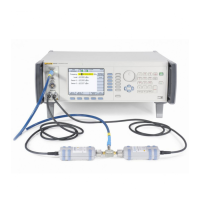96000 Series
Service Manual
3-14
9. Push the up () and down () keys on the Signal Source Analyzer to move
the marker across the phase-noise plot on the display to each of the offset
frequencies listed in Table 3-5. At each offset frequency, observe the marker
data on the display of the Signal Source Analyzer and verify the phase noise
is within the limit shown in Table 3-5.
10. Set the UUT output to STBY. Remove all connections to the Leveling Head.
Table 3-5. Phase Noise Test (96040A and 96270A)
Output Frequency Offset Specification
125 MHz 100 Hz < -121 dBc/Hz
1 kHz < -141 dBc/Hz
10 kHz < -148 dBc/Hz
100 kHz < -151 dBc/Hz
1 MHz < -153 dBc/Hz
10 MHz < -155 dBc/Hz
1 GHz
100 Hz < -104 dBc/Hz
1 kHz < -130 dBc/Hz
10 kHz < -140 dBc/Hz
100 kHz < -141 dBc/Hz
1 MHz < -148 dBc/Hz
10 MHz < -152 dBc/Hz
Modulation Test-Leveling Head (96040A and 96270A, Optional)
Equipment required for this test:
• Spectrum Analyzer/Measuring Receiver
• 50 Ω Leveling Head (supplied with UUT)
To verify the amplitude and frequency modulated outputs of the UUT:
Note
Verification of phase modulation is not required as phase modulation
is created as sinusoidal frequency modulation with peak deviation
derived from the phase deviation and rate settings.
1. Connect the output of the 50 Ω Leveling Head to the RF INPUT of the
Measuring Receiver.
2. On the Spectrum Analyzer/Measuring Receiver push PRESET and then
select Measuring Receiver Mode.
Note
It may be necessary to readjust the Measuring Receiver’s settings
from those automatically configured in the modulation measurement
mode. In particular, to ensure the demodulation bandwidth and
measurement time settings are adequate to accommodate the
modulated signal RF spectrum and to capture at least five cycles of
the modulation waveform.

